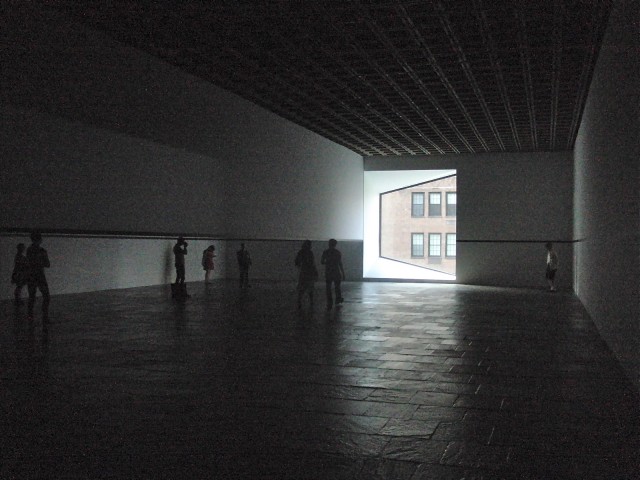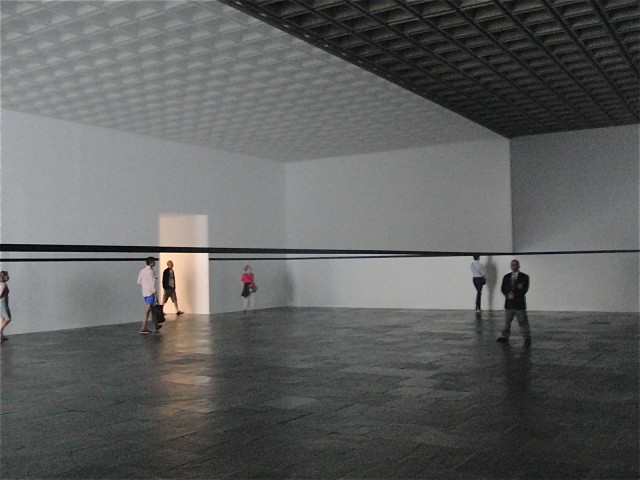
Robert Irwin’s site-specific “Scrim veil” invites visitors into its many charms and mysteries (photo by twi-ny/mdr)
Whitney Museum of American Art
945 Madison Ave. at 75th St.
Wednesday – Sunday through September 1, $16-$20 (pay-what-you-wish Fridays, 6:00 – 9:00)
212-570-3600
www.whitney.org
robert irwin photo set
As the Whitney prepares for its move to the Meatpacking District in 2015, it has been combing through its holdings, mounting exhibitions (“Sinister Pop,” “Signs & Symbols,” “Real/Surreal”) that offer new ways to experience works, both familiar and not, from its collection. One significant piece is being brought back for the first and last time, as it was designed specifically for the fourth floor of Marcel Breuer’s building and cannot be shown anywhere else. In 1977, California-based artist Robert Irwin installed “Scrim veil — Black rectangle — Natural light, Whitney Museum of American Art, New York,” a deceptively simple project made of cloth, metal, black paint, and wood. At one end of the rectangular room is Breuer’s trapezoidal window, streaming in oddly shaped light. A translucent scrim runs the length of the room, hanging from the ceiling, with five and a half feet from the floor to its black metal base, allowing people to easily walk under it. In addition, a black line has been painted along the wall at the same five-and-a-half-foot height, parallel to the base of the scrim. Upon exiting the elevators, visitors are instantly transported into the compelling space, which takes a bit of time to adjust to. “Scrim veil” is something that can’t just be seen but needs to be experienced; it seems to shift with changes in the outside light and as other people make their way around it. The black metal base of the scrim and the black painted line on the walls meld together then break apart, appearing to create morphing physical elements.

Robert Irwin, “Scrim veil — Black rectangle — Natural light, Whitney Museum of American Art, New York,” cloth, metal, and wood, 1977 (photo by twi-ny/mdr)
In the original exhibition catalog — “Scrim veil” was part of a larger show — Irwin, who is now eighty-four and still making challenging, fascinating new work, contributed the complex essay “Notes Toward a Model,” in which he explored the nature of form, context, content, perception, abstraction, conception, experience, and response. “There is probably no such thing as a pure naïve perception of the world,” he writes in the heavily illustrated discussion. “As noted earlier, we do not begin at the beginning in such matters but already somewhere in the middle. For example: Conceive in your mind the idea of a straight line (which has only a limited actuality in nature). In extended time consider our ‘straight line’ as the basis for the compounded abstraction known as Euclidean geometry. Again in extended time, consider a world developed and structured in line with our concept — i.e., grid to city; frame and plane to painting — point-to-point as a way of procedure through life. Now, place yourself in the middle of this milieu as the actual (physical) frame of your experiential reference, your reality, and ask yourself, ‘What can I know?’” (The full catalog can be read here.) Indeed, as one travels around the room, losing track of time and space, “Scrim veil” provides personal questions and answers that explore just what it is we might know about our individual and shared environment, both physically and psychologically. Interestingly, although Irwin was against the taking of photographs during the piece’s initial 1977 run, the Whitney is allowing pictures this time around, but don’t get too caught up in trying to snap a good photo and instead just allow yourself to be enveloped in this unique and involving experience, one that will never happen again.